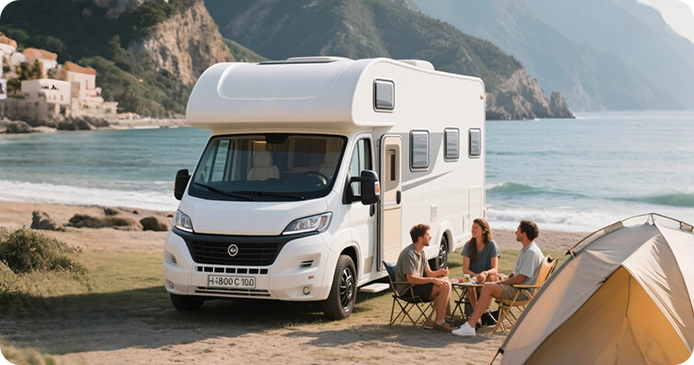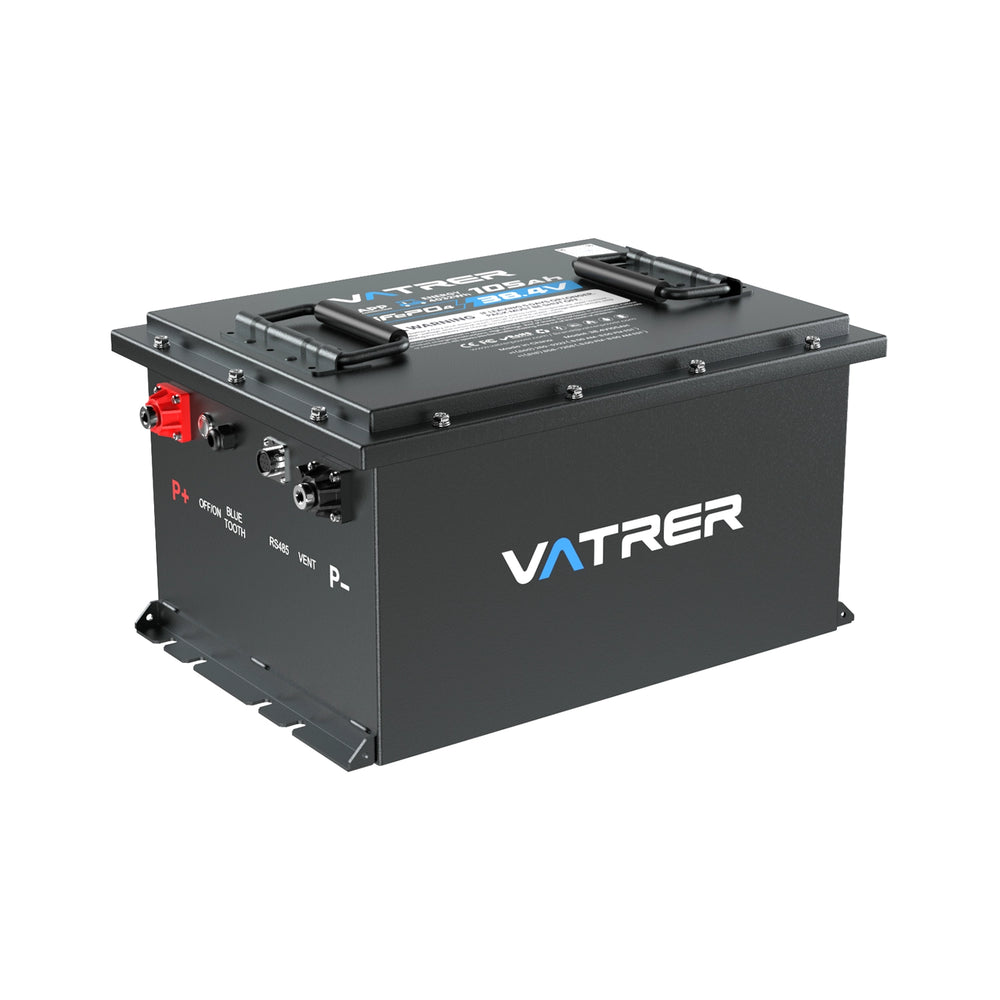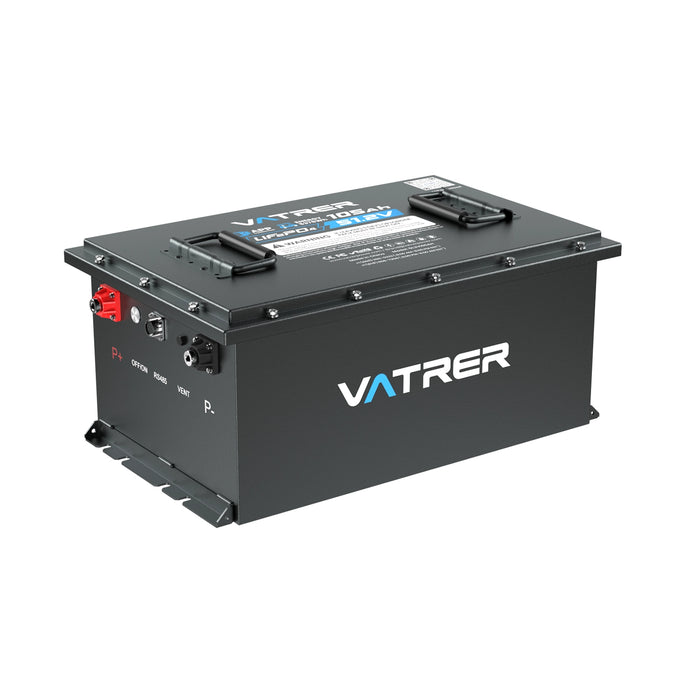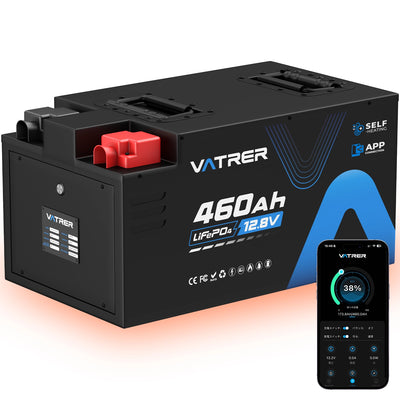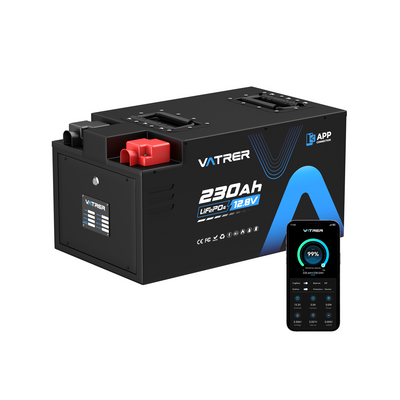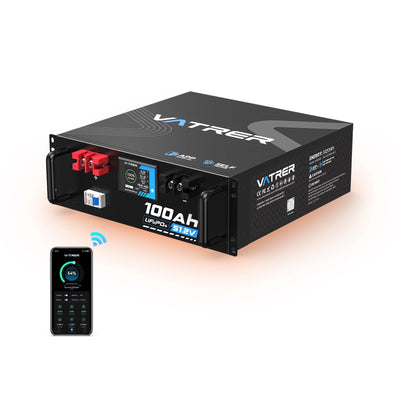
ゴルフカートに今すぐリチウム電池が必要な5つの理由(+手間をかけずにアップグレードする方法)
9番ホールでバッテリー切れにうんざりしていませんか?リチウムバッテリーへの変換で、航続距離の不安を解消し、充電時間を60%短縮し、バッテリー寿命を5倍に延ばす方法をご紹介します。Vatrerの実証済みアップグレードチェックリストをご覧ください。
ゴルフカート業界は長年にわたり、他の電動動力分野と同様に、従来のディープサイクル鉛蓄電池に大きく依存してきました。これらの電池は機能的には優れていますが、固有の限界があり、最新のリチウムイオン電池によってその限界は徐々に克服されつつあります。
ゴルフカートをリチウムに改造するのは単なる流行ではありません。
これは、パフォーマンスの向上、メンテナンスの大幅な削減、そして長期的な価値の向上を実現する、技術的に正しい決定です。
鉛蓄電池に対するリチウム(LiFePO₄)の主な技術的利点
- 優れたエネルギー密度と軽量:リチウムバッテリーは、より小型で軽量なパッケージに、より多くのエネルギーを詰め込んでいます。これによりカートの軽量化が実現し、加速性能とハンドリング性能が向上し、芝生の圧縮も軽減されます。さらに重要なのは、バッテリーの物理的な重量を減らしても、航続距離を延ばせることが多いことです。
- 長寿命サイクルと放電深度(DoD): LiFePO₄バッテリーは通常2,000~5,000回の充電サイクルに耐えますが、ほとんどの鉛蓄電池は500~1,000回です。さらに、LiFePO₄バッテリーは容量の80~100%まで放電しても大きな劣化はありません。一方、鉛蓄電池は50%を超える放電を繰り返すと早期劣化を引き起こします。
- 安定した電力供給:リチウム電池は、放電サイクル全体を通してより安定した電圧出力を維持します。つまり、鉛蓄電池によくある顕著な電圧低下とは異なり、バッテリーが消耗してもカートの動作が鈍くなることはありません。
- より速い充電と効率:リチウム電池はより高い充電電流に対応できるため、充電時間を大幅に短縮できます。また、鉛蓄電池(約80~85%)と比較して充電効率(約95%以上)が高く、無駄な電力消費を抑えます。
- 実質メンテナンスフリー:水やり、酸腐食による端子洗浄、電解液の層別化の心配はもう必要ありません。LiFePO₄バッテリーは密閉型ユニットのため、定期的なメンテナンスは不要です。
- 強化された安全性: LiFePO₄ は一般的なリチウムイオン化学物質の中で最も安全で、優れた熱安定性を備え、充電中に水素などの有害なガスを放出するリスクがないため、屋内での保管や取り扱いがより安全です。
リチウムアップグレードが技術的に正当化されるのはいつですか?
エンジニアリングの観点から見ると、アップグレードの指標は明確です。
- バッテリーの健全性の低下:端子の目に見える腐食、ケースの膨張やひび割れ、あるいは酸漏れは、直ちに危険信号となります。これらは鉛蓄電池の寿命が近づいていることを示しており、潜在的な安全上の問題となります。
- 容量と性能の低下:カートの航続距離が短くなったり、坂道で苦戦したり、フル充電後も加速が鈍くなったりする場合は、鉛蓄電池の内部抵抗が増加し、実効容量が低下している可能性があります。負荷テストまたは容量放電テストを行うことで、この劣化を定量化できます。
- 過度のメンテナンス要求:ターミナルの清掃、水位のチェック、または細心の注意を払っているにもかかわらずパフォーマンスの低下に対処するために多大な時間を費やしている場合、鉛蓄電池の運用コスト (時間とリソース) は法外なものになっています。
- 優れた動作特性の要求:より長い走行距離、安定した電力、使用間のターンアラウンド時間の短縮、あるいは車両全体の重量軽減が必要な場合、リチウムは論理的な選択です。
適切なリチウム電池システムの選択方法
適切なリチウム電池を選ぶには、ブランドだけではなく、カートの電気システムと運用上のニーズに合った仕様を選ぶことが重要です。
- 電圧マッチング(システム電圧):ほとんどのゴルフカートは36Vまたは48Vシステムで動作します。従来は複数の6V、8V、または12Vの鉛蓄電池を直列に接続することで実現していましたが、現代のリチウム電池では、適切な定格のLiFePO₄バッテリーパックを1つ使用することが多くなっています。例えば、48Vシステムには、公称電圧48VのLiFePO₄バッテリーを組み合わせる必要があります。これにより配線が簡素化され、直列接続されたセル間の不均衡が排除されます。低電圧リチウム電池を複数直列で使用する場合は、そのような構成向けに特別に設計され、堅牢なバッテリー間バランス調整機能が備わっている場合を除き、使用しないでください。
-
容量(アンペア時間、Ah) - 範囲のサイズ
- 典型的な1日のエネルギー消費量を把握しましょう。平均走行距離と地形を考慮してください。
- リチウムは効率が高く、許容放電深度も広いため、Ah-Ahバッテリーの直接交換は不要になる場合があります。100Ah LiFePO₄バッテリーは、蓄電量をより多く活用できるため、150Ah鉛蓄電池と同等、あるいはそれ以上の航続距離を実現できる場合が多くあります。
- 航続距離を延ばすには、同じ電圧のLiFePO₄バッテリーを複数並列接続することがよくあります。例えば、48V 50Ahのバッテリーを2つ並列に接続すると、48V 100Ahのシステムを構築できます。
- 物理的寸法(「ドロップイン対応」):既存のバッテリーコンパートメントのサイズを測ります。多くのリチウムバッテリーサプライヤーは、一般的な鉛蓄電池の設置面積に合わせて設計された「ドロップイン」サイズを提供しています。これにより設置が簡素化され、大きな改造をすることなくバッテリーを安全に取り付けることができます。
- バッテリー管理システム(BMS):重要なコンポーネントです。ご購入いただくリチウムバッテリーには必ずBMSが内蔵されていることを確認してください。この重要なシステムは、過充電、過放電、過電流、極端な温度からセルを保護し、安全性と長寿命を確保します。
変換プロセス
機械に精通した人であれば、この変換を実行できる人も多くいますが、精度と安全性が最も重要です。
-
準備と安全
- 電源を切る:必ず既存のバッテリーパックからメインのマイナスケーブルを最初に外し、次にメインのプラスケーブルを外してください。これにより、偶発的なショートを防ぐことができます。
- 既存配線の評価:ケーブルの摩耗、腐食、またはゲージ不足を点検します。必要に応じて交換します。
- コンパートメントを清掃する:古い電池を取り外し、電池トレイの酸の残留物や腐食を徹底的に除去します。
-
インストール
- 安全な取り付け:新しいリチウム電池 (または電池群) をトレイに置き、取り付けストラップまたはブラケットを使用して適切に固定します。
-
配線接続:
- 直列接続(リチウムドロップインによる一次電圧の実現には通常推奨されません):何らかの理由で、低電圧のリチウム電池(例えば、12V LiFePO₄を4個使用して48Vにするなど)を使用してシステム電圧を実現する場合は、正極と負極を順番に接続してください。合計電圧は個々の電池の電圧の合計となり、容量(Ah)は直列接続の中で最も容量の低い電池の容量のままになります。注:電池が直列接続用に設計されていない限り、セルバランス調整が複雑になる可能性があるため、一般的に、電圧が一致する単一の電池を使用する場合よりも理想的ではありません。
- 並列接続(容量増加のため):適切なシステム電圧のリチウム電池を複数個使用する場合(例:48V LiFePO₄電池2個)、すべての正極端子とすべての負極端子を並列に接続します。電圧は一定で、総容量(Ah)は個々の電池容量の合計となります。
- メインケーブルの再接続:まず、メインのプラスケーブルをバッテリーパックのプラス端子に接続します。次に、メインのマイナスケーブルを接続します。すべての接続がしっかりと固定されていることを確認してください。分解前に、元の配線構成(特にキースイッチやコントローラーなどへの制御配線)の写真を撮っておくことを強くお勧めします。
-
充電システムの互換性: 重要!
- LiFePO₄専用の充電器を使用する:これは必須です。鉛蓄電池用の充電器は異なる充電プロファイル(アルゴリズム)を使用するため、LiFePO₄バッテリーに損傷を与えたり、正しく充電できなかったりする可能性があります。LiFePO₄充電器は通常、CC/CV(定電流/定電圧)プロファイルを使用します。
- 充電器の電圧:充電器の出力電圧は、リチウム電池パックの公称電圧と一致する必要があります(例:48V LiFePO₄電池には48V充電器)。低電圧電池を直列接続している場合(例:12Vを4つ接続して48Vにする場合)、理想的には12V LiFePO₄充電器で個別に充電するか、専用のマルチバンク充電器を使用するか、電池パックのBMSが個々のセル/モジュールの直列充電を効率的に管理するように設計されている場合に限り、 48V充電器を使用してください。48V電池を並列接続している場合は、総容量に合わせたサイズの48V LiFePO₄充電器1台で十分です。
- 換気: LiFePO₄ バッテリーは鉛蓄電池のようにガスを放出しませんが、充電中は常に換気を良くすることが賢明です。
費用便益分析
- 初期投資:リチウム電池は鉛蓄電池に比べて初期費用が高くなります(容量、ブランド、機能によって1,000ドルから3,500ドル以上)。DIYで改造しない場合、工賃は1時間あたり100ドルから150ドル以上かかる場合があります。
-
総所有コスト (TCO):ここがリチウムの強みです。
- 交換頻度の削減:サイクル寿命が 3 ~ 5 倍になるため、カートの寿命期間中に購入するバッテリーの数が減ります。
- メンテナンス費用なし:蒸留水、端末保護剤、維持のための人件費が不要になります。
- 省エネ:充電効率が高ければ、無駄な電気が少なくなります。
- パフォーマンスと稼働時間の向上:ダウンタイムの短縮、安定した電力供給、充電の高速化により、運用上の価値が向上します。
- 軽量化:カートと芝生の磨耗が軽減されます。
リチウムゴルフカートバッテリーのメンテナンス
LiFePO₄バッテリーはメンテナンスの手間が非常に少ないです。
- 充電:使用後は可能な限り充電してください。鉛蓄電池とは異なり、「メモリー効果」がなく、部分的な充電状態も一般的に良好に許容されます。ただし、最適な寿命を得るには、非常に低い充電状態(例:10%未満)または非常に高い充電状態(避けられる場合は長期間100%)で保管することは避けてください。ほとんどのBMSシステムは過放電を防止します。
- 保管:涼しく乾燥した場所に保管してください。長期間(数か月)保管する場合は、50~70%程度の充電状態を目安にしてください。
- 接続:端子の接続が清潔でしっかりと固定されていることを定期的に確認してください。
結論
ゴルフカートを鉛蓄電池から LiFePO₄ リチウム電池に交換することは、技術的に確実な投資であり、パフォーマンス、走行距離、寿命、利便性が大幅に向上するとともに、メンテナンスの負担も大幅に軽減されます。
初期投資は高額ですが、優れたエンジニアリング、運用上の利点、および総所有コストの低減により、米国市場の目の肥えたゴルフカート所有者にとって魅力的なアップグレードとなっています。
変換を成功させ、長持ちさせるためには、高品質のコンポーネント、特に堅牢な BMS と専用の LiFePO₄ 充電器を備えたバッテリーを選択してください。


























